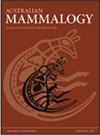Non-preferred habitat increases the activity area of the endangered northern quoll (Dasyurus hallucatus) in a semi-arid landscape
IF 1.2
4区 生物学
Q3 ZOOLOGY
引用次数: 0
Abstract
36 Animal conservation requires a sound understanding of the movement ecology and habitat 37 selection of the species in question. A key component of this is identifying habitats that animals 38 actively seek or avoid. We quantified habitat selection and investigated the drivers of 39 variability in the short-term activity area of a small, endangered mesopredator, the northern 40 quoll ( Dasyurus hallucatus ), in the Pilbara region of Western Australia. We collated, 41 standardised, and analysed 14 northern quoll GPS tracking events from four studies conducted 42 between 2014 and 2018. Northern quolls selected activity areas in locations that were more 43 topographically rugged than the broader landscape, characterised by higher percentage cover 44 of rocky habitat and riverbed, and lower percentage cover of spinifex sandplain. The size of 45 their activity area also increased with higher percentage cover of non-preferred spinifex 46 sandplain. Therefore, the destruction of habitats preferred by northern quolls—such as mining 47 of rocky habitat—and introduction of structurally simple habitat like spinifex sandplain, is 48 likely to negatively impact resource availability and lead to altered movement patterns that 49 could decrease survival. Future conservation planning should place emphasis on the protection 50 of rugged rocky habitat for northern quolls, as well as efficient movement pathways between 51 patches of this critical habitat. 52非首选栖息地增加了濒临灭绝的北袋鼬(Dasyurus hallucatus)在半干旱景观中的活动区域
动物保护需要对有关物种的运动、生态学和栖息地选择有充分的了解。其中一个关键部分是确定动物积极寻找或避免的栖息地。我们量化了栖息地选择,并调查了西澳大利亚皮尔巴拉地区一种小型濒危中食肉动物——北袋鼬(Dasyurus hallucatus)短期活动区域的39种变异的驱动因素。我们整理、标准化和分析了2014年至2018年期间进行的四项研究中的14项北方袋鼠GPS跟踪事件。北方鼬鼠选择的活动区域地形崎岖,而不是广阔的景观,其特点是岩石栖息地和河床的覆盖率较高,而刺状沙平原的覆盖率较低。随着非首选棘草沙地覆盖率的增加,其活动区域的大小也随之增加。因此,破坏北方鼬喜欢的栖息地(如开采岩石栖息地)和引入结构简单的栖息地(如刺状沙平原)可能会对资源的可用性产生负面影响,并导致运动模式的改变,从而降低存活率。未来的保护规划应把重点放在保护北袋鼬崎岖的岩石栖息地上,以及在这一重要栖息地的51个斑块之间建立有效的移动通道。52
本文章由计算机程序翻译,如有差异,请以英文原文为准。
求助全文
约1分钟内获得全文
求助全文
来源期刊

Australian Mammalogy
ZOOLOGY-
CiteScore
2.50
自引率
8.30%
发文量
26
期刊介绍:
Australian Mammalogy is a major journal for the publication of research in all branches of mammalogy. The journal’s emphasis is on studies relating to Australasian mammals, both native and introduced, and includes marine mammals in the Antarctic region. Subject areas include, but are not limited to: anatomy, behaviour, developmental biology, ecology, evolution, genetics, molecular biology, parasites and diseases of mammals, physiology, reproductive biology, systematics and taxonomy.
Australian Mammalogy is for professional mammalogists, research scientists, resource managers, consulting ecologists, students and amateurs interested in any aspects of the biology and management of mammals.
Australian Mammalogy began publication in 1972 and is published on behalf of the Australian Mammal Society.
 求助内容:
求助内容: 应助结果提醒方式:
应助结果提醒方式:


